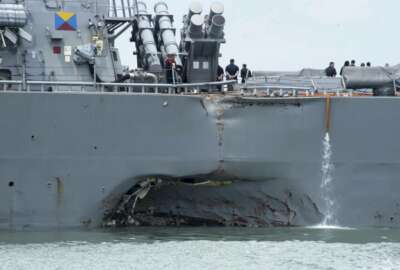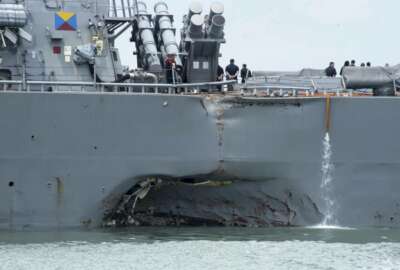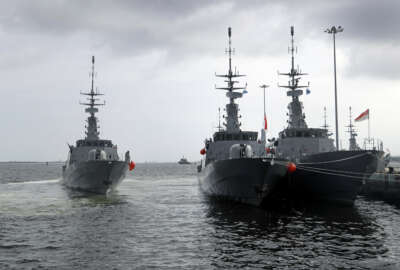
Navy says it’s closed training, certification gaps in accident-prone 7th Fleet
Navy says all of its Japan-based ships are caught up on training, certification standards, a dramatic departure from a year ago.
Top Navy officials told members of Congress that they had made substantial progress in undoing a “normalization of deviance” from training and certification standards that contributed to last year’s deadly collisions in the western Pacific.
At this point, none of the ships in the Japan-based forward-deployed fleet are operating without the certifications required for their missions, Adm. John Richardson, the chief of naval operations said in testimony before the House Armed Services Committee.
That situation is a major contrast from the one that existed on the two vessels aboard which 17 sailors lost their lives in 2017: On the U.S.S. Fitzgerald, 15 of 22 required certifications were expired, on the U.S.S. John McCain, seven had lapsed. Across the chronically-undermanned Japan-based fleet, the number of expired certifications jumped from 6 percent in 2015 to 40 percent in 2017, and nearly 100 percent of vessels had at least one expired certification.
“That’s the exact definition of normalization of deviance,” Richardson said. “It started as risk mitigation: ‘Hey, we know you can’t get this done, but here’s the mitigating measures we’ll take, we’ll reschedule that.’ It devolved into almost a rubber stamp, and that was clearly articulated in our comprehensive review.”
Richardson and Richard Spencer, the secretary of the Navy, said the service has completed several other near-term steps to improve safety and seamanship across its surface fleet, including mandating watch schedules that match natural circadian rhythm cycles, implemented new safety procedures when Navy vessels are within two miles of any other ship, sped up the deployment of new shipboard navigation technologies, and implementing monthly assessments to ensure crew members have a firm grasp of international maritime rules of the road.
But in order to prevent the widespread failures to meet standards from relapsing, officials said the Navy needs a single, high-level organization to serve as an advocate for force generation, training and certification. Under current law, the Navy is not allowed to establish such an organization without assent from Congress.
Legislative language originally crafted by the late Sen. Daniel Inoye, and which has continued to be added to the Defense Department’s annual appropriations bills, requires that the Hawaii-based U.S. Pacific Fleet retain control over manning, training and equipping functions for forces that are in its geographic area of responsibility. For forces in the rest of the world, the Navy consolidated those responsibilities under the Norfolk, Va.-based U.S. Fleet Forces Command more than a decade ago.
“[The Inoye Amendment] is an intrusion by Congress in terms of how the command and control structure is designed,” said Rep. Joe Courtney (D-Conn.), the ranking member of the seapower and projection forces subcommittee. “If that was removed, it really allows the Navy to move forward with a more optimal arrangement and to untangle the conflicts.”
Both Spencer and Richardson agreed, and Navy studies conducted in the aftermath of the incidents also pointed to the bifurcation of authorities between Fleet Forces Command and the Pacific Fleet as contributors to the Navy’s readiness problems.
“The lack of an accountable commander responsible for training and certification is another facet of staff reorganizations that has obscured the focus on fleet readiness and contributed to the normalization of deviation in the Navy,” wrote the authors of the service’s Strategic Readiness Review, published in December.
But Spencer said the Navy’s East Coast-West Coast separation is only one of the bureaucratic organizational issues he and a panel of advisors are examining in response to the review.
“We sat down and looked at the entire wiring diagram for command and control in the Navy with two goals in mind: the commander of a ship should have a clear line to know what he or she is reporting to and whom, and we should also have a clear line of sight from command on down as to where responsibility should lie,” he said. “We have not come to final conclusions yet, and we’ll have our first step forthcoming soon, but we need to clean up the ability for us to act in the most efficient way possible with the most direct lines of communication.”
But some members of Congress were not predisposed to the idea of eliminating the Inouye amendment, arguing that the Pacific theater World War II veteran and Medal of Honor awardee had well-founded, well-informed reasons for insisting on a degree of autonomy for the Pacific Fleet.
“Their [area of responsibility is almost 55 percent of the earth’s surface,” said Rep. Colleen Hanabusa (D-Hawaii). “I don’t disagree with a single standard of excellence, but I want to impress upon you that the Pacific is different. Where these accidents occurred is in a very busy area where we’re faced with a lot of commercial traffic.”
Even as Navy officials said they were seeking to boost the fleet’s adherence to existing training and certification standards, they said they were not taking it as a given that all of the service’s inspection, certification and training requirements were completely necessary, at least as they are written today.
“We want to make sure we’re inspecting at the proper frequency and that those inspections are useful to the crew, particularly the commanding officer, so that he or she can make the adjustments and continue to improve their crew,” Richardson said. “The comprehensive review found that there were something on the order of 300 inspections in a typical training cycle, many of which never spoke to the commanding officer, and it’s hard to even keep track of those. Not all deficiencies are created equal when it comes to the materiel readiness to conduct combat operations, and so we’re very interested in moving forward to make sure our INSURV inspections are at the proper periodicity and looking at the proper things.”
But the Navy leaders hastened to add that Congress also bears a fair degree of responsibility for sub-optimal readiness, considering the ongoing effects of the Budget Control Act, a sudden slicing away of readiness funds during the 2013 sequestration, and the persistence of continuing resolutions as a mechanism for funding the government.
Those effects have been “toxic and corrosive,” Richardson said.
“We are getting after the work we have to do, but the absence of stable and adequate funding makes everything our sailors and their commanders do harder,” he said. “On a scale of 1 to 10, the absence of stable and adequate funding scores an 11.”
Copyright © 2025 Federal News Network. All rights reserved. This website is not intended for users located within the European Economic Area.
Jared Serbu is deputy editor of Federal News Network and reports on the Defense Department’s contracting, legislative, workforce and IT issues.
Follow @jserbuWFED






